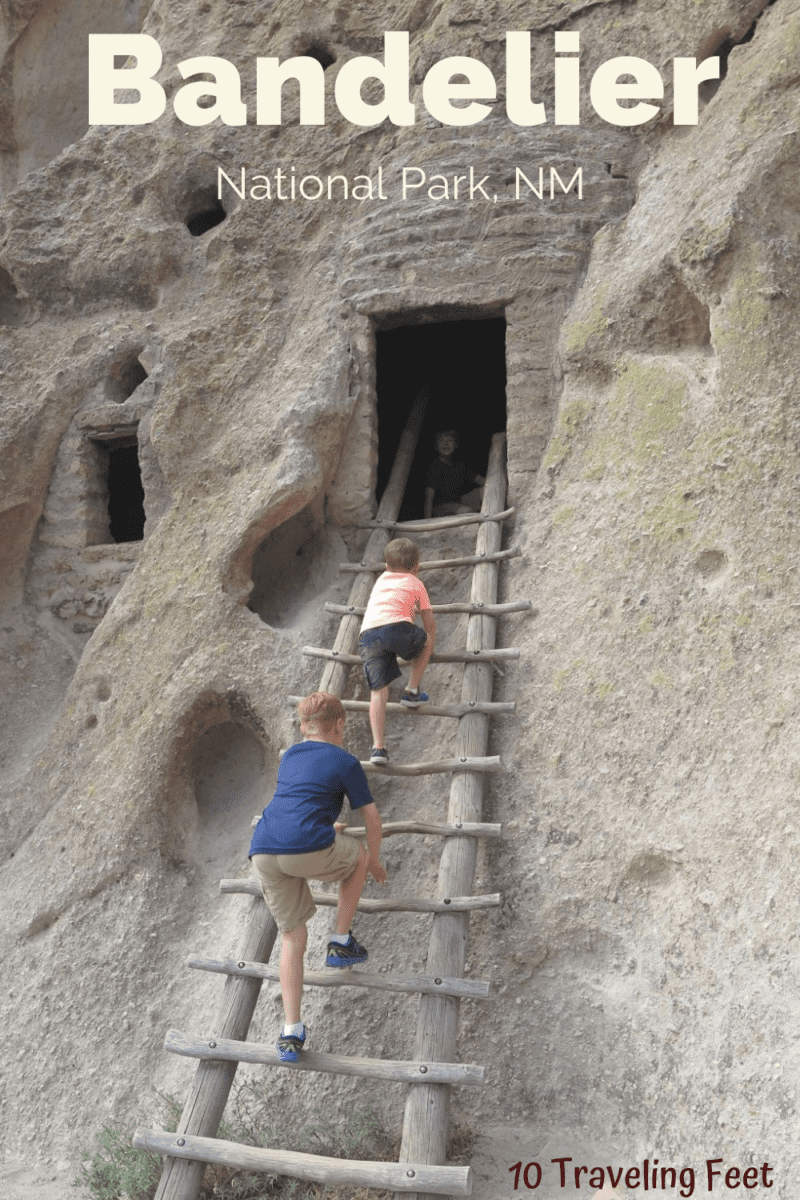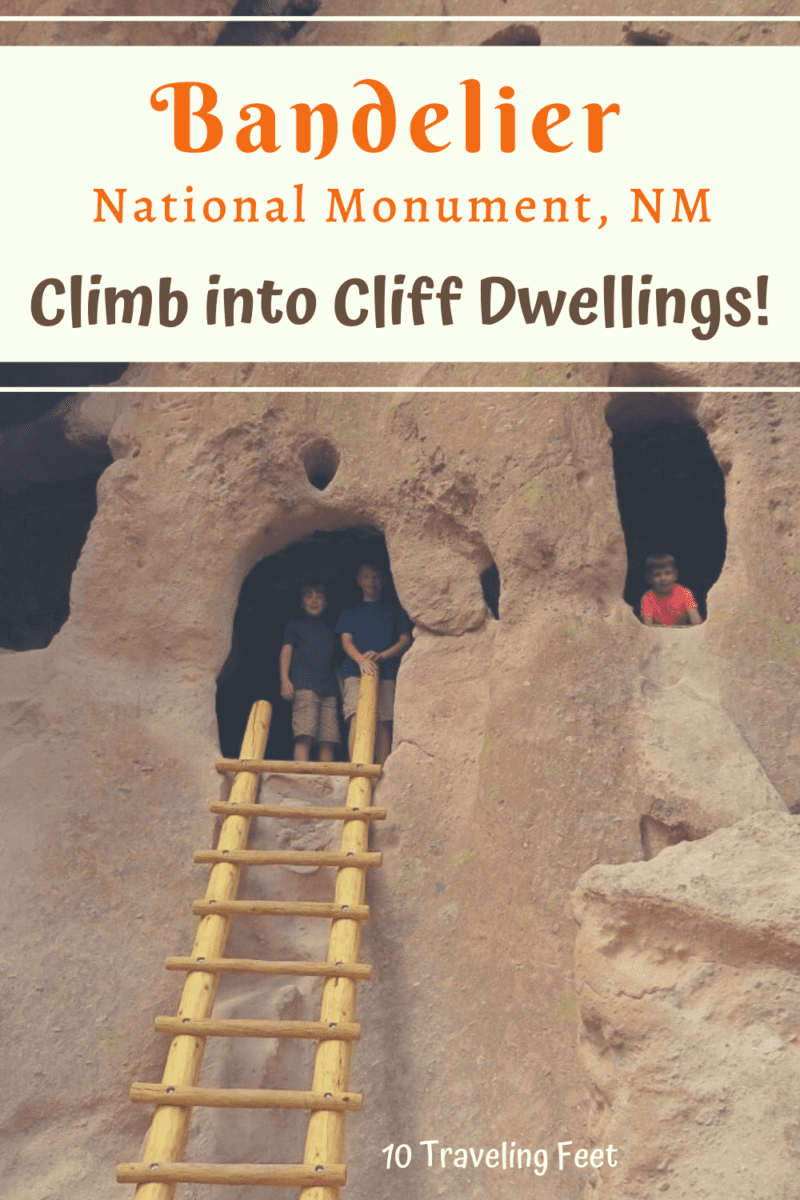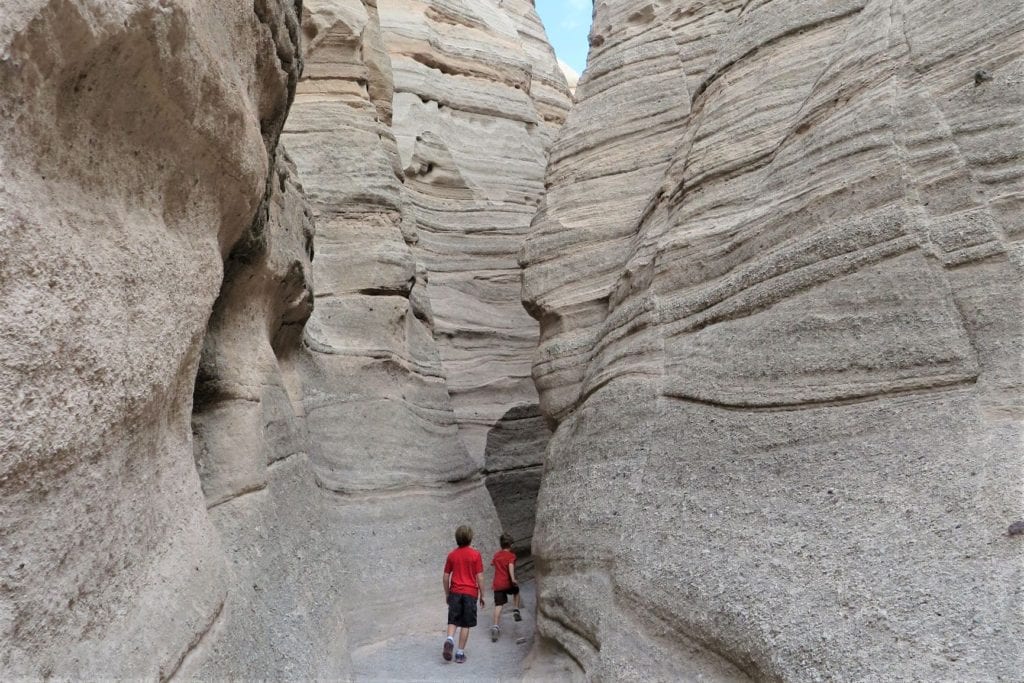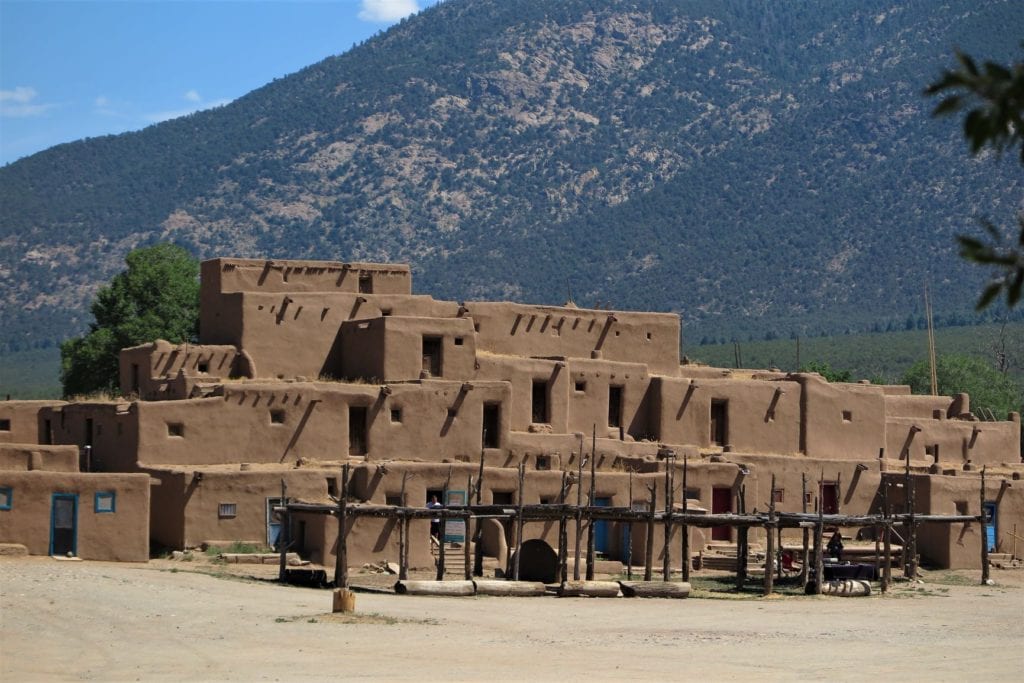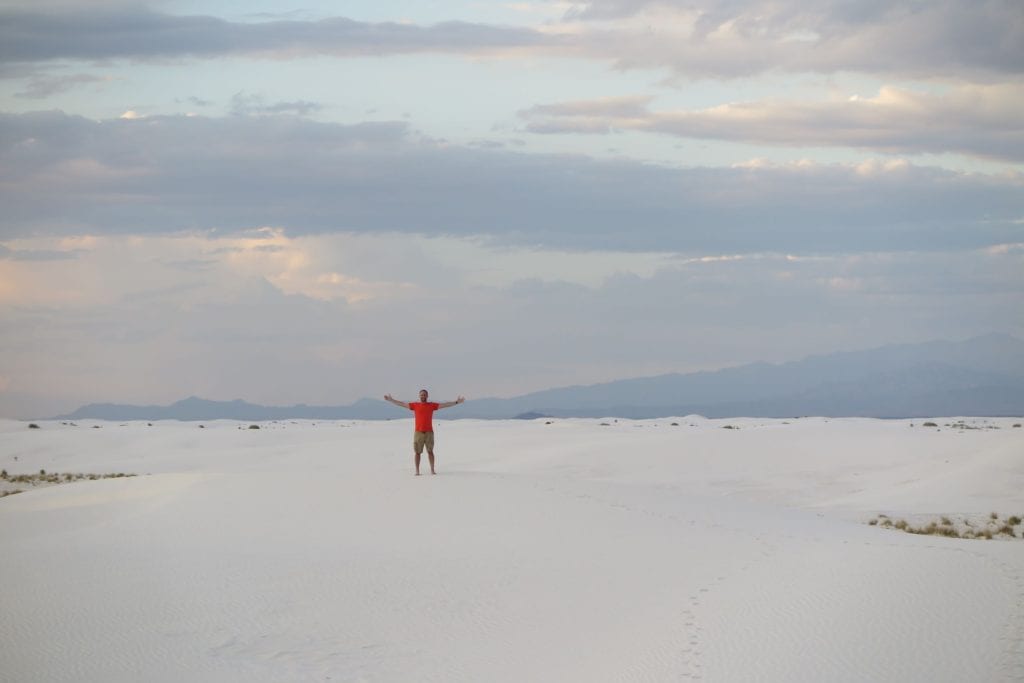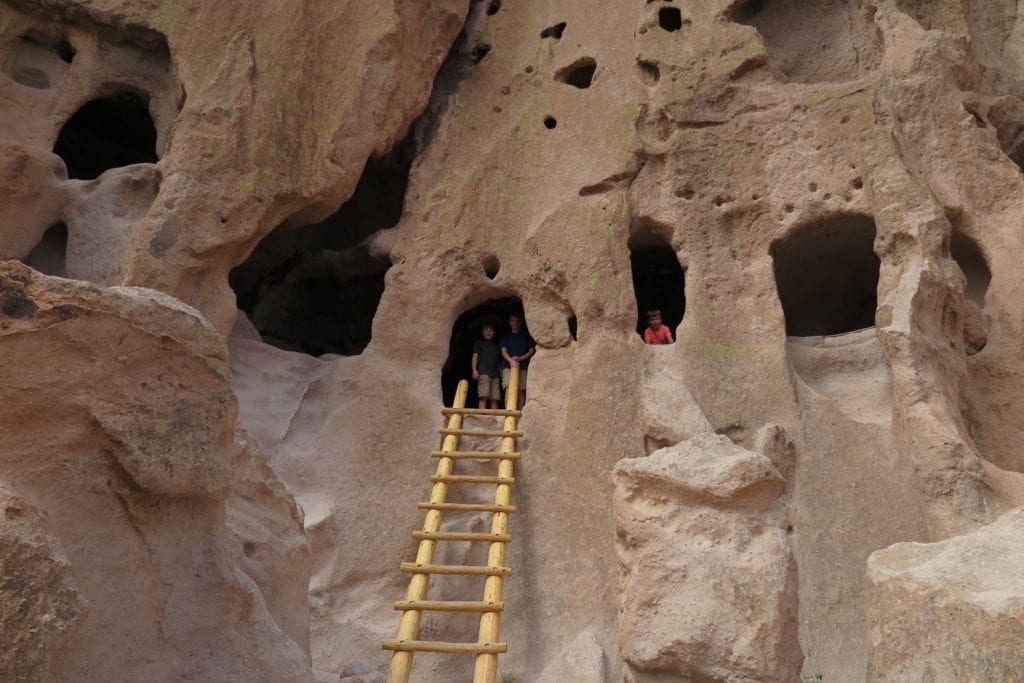
Journey back in time, at Bandelier National Monument, to when the Ancestral Pueblo people lived in the Frijoles Canyon of New Mexico.
Discover their ancient ruins. Climb into their age-old dwellings. And witness their petroglyph and pictograph images that were so created long ago. Bandelier National Monument is less than 1 hour from Santa Fe and is a wonderful addition to any road trip through New Mexico.
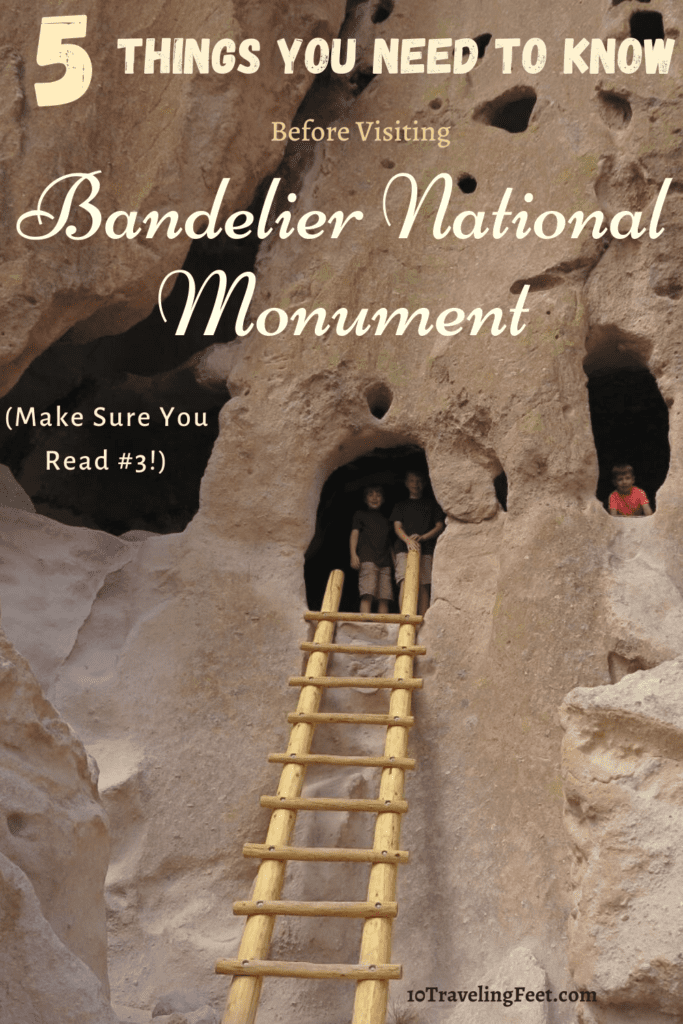
5 Things You Need to Know Before Visiting Bandelier National Monument
1. Top Things to Do at Bandelier National Monument
Main Loop Trail
The Main Loop Trail is the most popular thing to do at Bandelier National Monument. This trail is 1.2 miles long and weaves among the top archaeological sites of Bandelier. A highlight for our family on this trail was being able to climb up and down the ladders to go in and out of their ancient dwellings. This was a lot of fun!
Before you begin your journey on this trail, we recommend picking up a $2 trail guide from the Visitor Center. This will help you learn more about each of the fascinating 21 stops that are numbered along the Main Loop trail.
On Main Loop Trail you will stroll through the ruins, learn a little about the purpose of each structure and discover more about their fascinating building techniques. You can venture up several separate ladders to check out the different cavates carved into the cliffs and then imagine what life must have been like 600 years ago for the Ancestral Pueblo People.
Bandelier National Monument is a great place to visit, learn more about the past and explore.
The Main Loop Trail is the perfect way to see the best of Bandelier.
This trail takes approximately 45 minutes – 1 hour
The Top Sites on Main Loop Trail
Big Kiva – This was the Communal Meeting Place of the Ancestral Pueblo people.
Tyuonyi – (See Below) This structure was once two stories tall with over 400 rooms. Most of the rooms here were used for storing food.
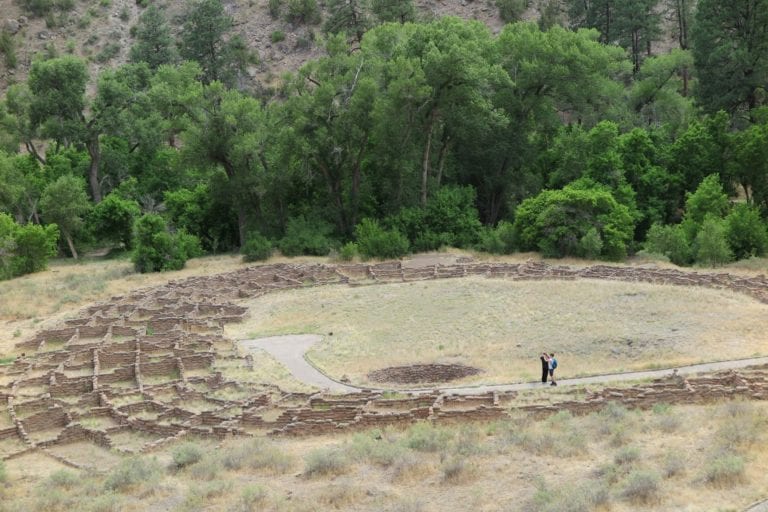
Talus House – This house was reconstructed in 1920 and was built from rock debris from the bottom of the cliff. Talus houses used to stand in front of the cavates.
Cavates – Cavates are small human carved alcoves into the volcanic tuff.
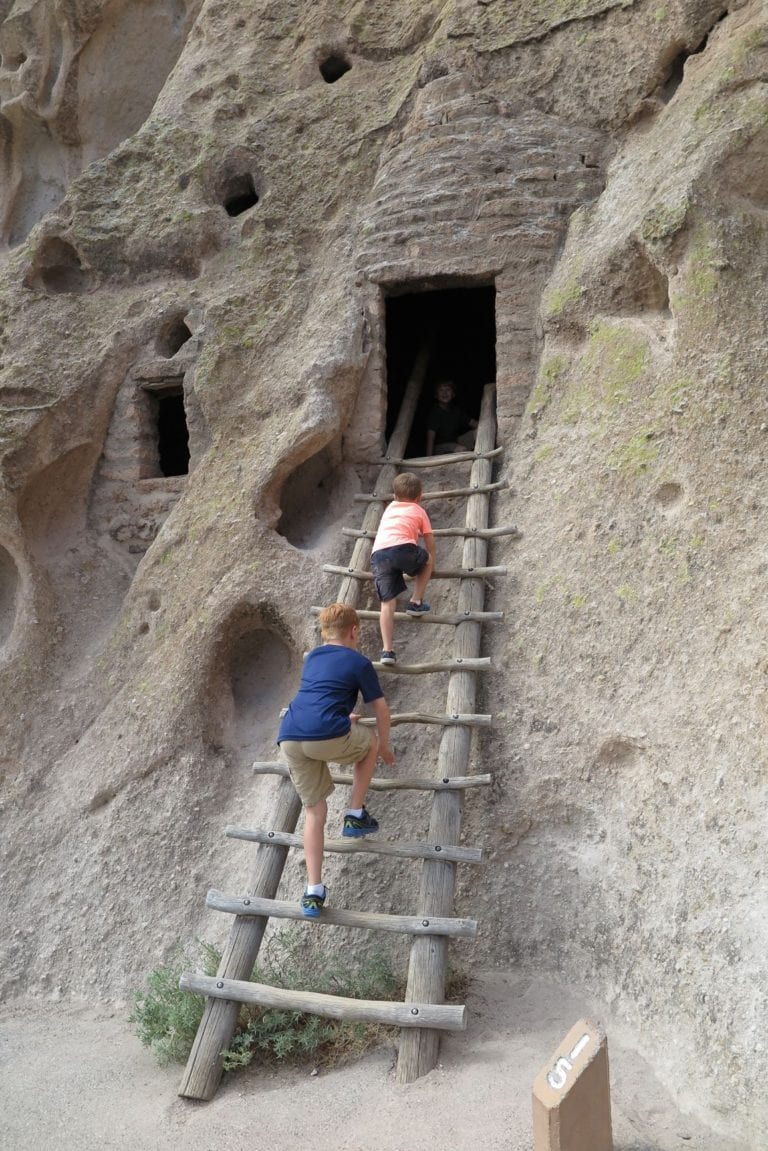
Climb into Ancient Cliff Dwellings!
Ladders allow you to enter into a couple different cavates along the trail! This was our kids favorite part!
These cavates are great places to stop and take a minute to look around and try to imagine what life must have been like. This is also a great visual spot for children to try and understand more about the Ancestral Pueblo people’s way of life. Have your children look for where they built their fire? Where did they sleep? Ask them how their life would be different if they lived in this cavate?
These are great questions that can really get your child thinking about how their life is different (or even the same) from the Ancestral Pueblo people.
The Long House – Here you can see how homes were built along the base of the cliff. This allowed them to build structures that were 3 – 4 stories tall!
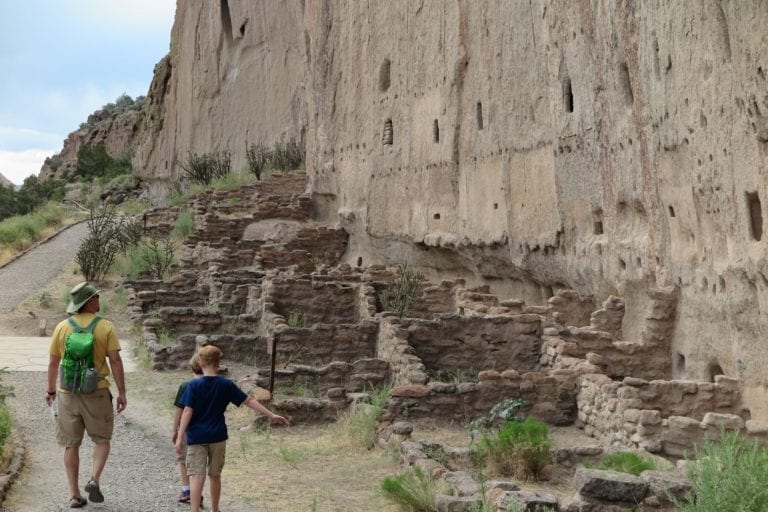
Here you can see the circular holes in the cliff side where beams were placed to create each level of their structure. You can also see the cavate holes carved into the cliff side. Entry into these cavates would have been through the 3-4 story structure in front of them.
I found the building structures and techniques of the Ancestral Pueblo people fascinating!
Kid’s Books About SW Native American Culture:
10 Traveling Feet is a participant of Amazon Associates which means means we may receive a small commission, at no cost to you, if you make a purchase through a link. I will only recommend products that I have found useful and have loved using with my family. Thank you for supporting this website so that I may continue to bring you quality information.
2. Who Lived in the Bandelier Cliff Dwellings?
Native American activity in the Frijoles Canyon extends back at least 11,000 years! But it wasn’t until approximately 1150 AD that the Ancestral Pueblo people began to build a more permanent settlement in this area.
Today, at Bandelier National Monument, you can get a glimpse into the Ancestral Pueblo people’s lives from what they have left behind. Here, visitors can explore inside their ancient dwellings that were carved out of the volcanic tuff in the cliffs. You can look for the small holes in the cliff walls where they placed beams of Ponderosa pine trees to create multi-storied homes. And you can learn how this group of people became farmers and planted crops along the mesatop fields within this canyon.
Learning these skills and techniques allowed the Ancestral Pueblo people to thrive in this area until approximately 1550 AD. At this time the land here could no longer support their growing community. This combined with a severe drought caused them to move from their homes to areas along the Rio Grande.
From oral history and their traditions, we recognize the people of the Cochiti Pueblo, located just south and east on the Rio Grande as the Ancestral Pueblo people’s most direct descendants today.
Learn About the Ancestral Puebloan People
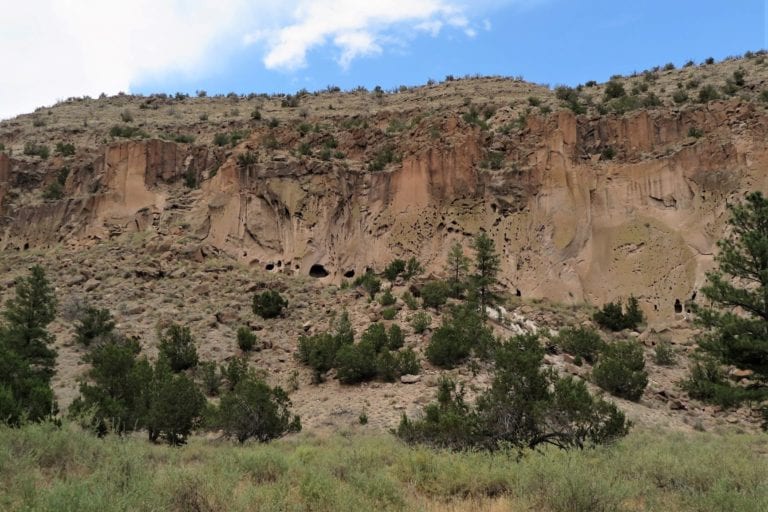
How many cavates (ancient dwellings in the cliffsides) can you find?
3. Important Information for Summer Visits!
Bandelier National Monument Shuttle
Summer Park Entry is by Shuttle Bus Only!
Before our family visited Bandelier National Park, I found it slightly confusing about how to visit and their shuttle rules so I wanted to simplify it here.
First of all the park is open from dawn until dusk and the Visitor Centers are open from 9am-5pm.
Usually during the summer, between the hours of 9am-3pm, you must park at White Rock Visitor Center first and then you are required to take the free shuttle from this Visitor Center to the Frijoles Canyon Visitor Center at Bandelier National Monument. (This is due to parking issues.)
Exceptions to Riding the Shuttle
If you arrive before 9am or after 3pm then you may drive directly to Bandelier yourself. Just make sure you pay the entrance fee at the White Rock Visitor Center, the kiosk near the shuttle pick up or at the park visitor center when you arrive. Your receipt or National Park Pass should then be displayed in your car. You can drive out and leave the monument at anytime, but if you return between 9am-3pm then you’ll need to take the shuttle to reenter.
The free shuttle runs every 30 minutes on weekdays and every 20 minutes on weekends.
The last shuttle leaves the Frijoles Canyon Visitor Center at 5pm.
There are a few other exceptions for people to be able to drive straight to Bandelier and not use the shuttle. These exceptions are found on their website here.
I hope that this helps decrease any confusion about how to see this magnificent site.
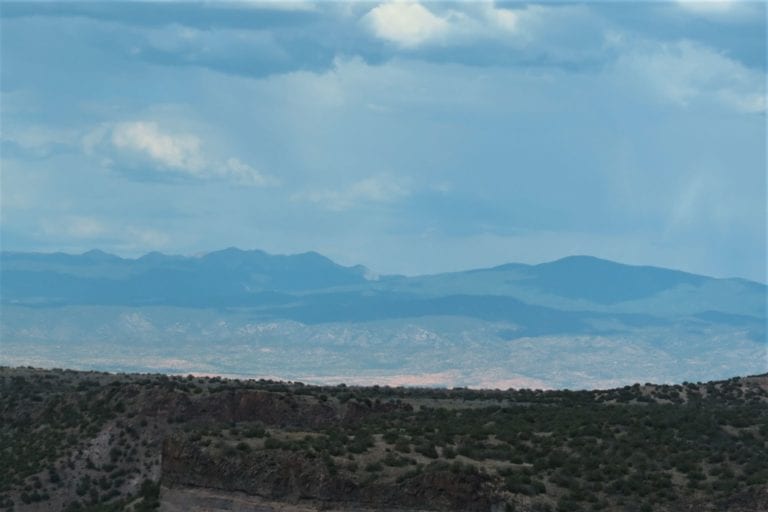
The view the Ancestral Pueblo people had of the land from their cliff dwellings.
4. The Junior Ranger Program at Bandelier National Monument, New Mexico
Bandelier National Monument has a great Junior Ranger Program that’s not just for kids! Mom and Dad can join in on the fun too!
Just pick up a free booklet from the Visitor Center and complete the activities that correspond with your age grouping (from 5 years old to 7th grade and up). Before you leave, show your booklet to a ranger and you will be sworn in as an Official Junior Ranger and receive a Bandelier Junior Ranger wooden badge!
We love the Junior Ranger Program! These programs are available at over 200 US National Parks and they really help families learn more about the park that they are in.
The Junior Ranger Badges are also great keepsakes (and they can help save you money at the gift shop since your kids already have a memento.)
But more importantly, I love how the activities in the Junior Ranger Program booklets really get kids thinking about where they are and why the site they are at is significant.
Small Road Trip Toys We Love (For Your Journey to Bandelier)
5. General Information About Bandelier National Park
Location – Bandelier National Monument is located in Northern New Mexico approximately 100 miles north of Albuquerque.
Fees – $25 per vehicle (7 day Entry Permit) or Free with the America the Beautiful Pass, Fourth Grade Pass, Active Military Pass or Senior Pass.
Trails – Bandelier has over 70 miles of trails that offer countless opportunities for all day hikes and mulit-day overnight backpacking trips.
The Tsankawi section of Bandelier is 12 miles from the main section of the park. Here you can take a 1.5 mile trail and walk along a mesa, view cavates, petroglyphs and the Ancestral Pueblo village of Tsankawi. Being able to climb a ladder is required for this trail.
Weather – June is hot and dry. Don’t forget to bring plenty of water.
Also, be aware that July and August have frequent afternoon thunderstorms.
Flash Flooding – Know that this is an area that can have flash floods, especially during the rainy season (July-Sept). Always check for any alerts.
Evening Campfire Programs and Night Sky Programs are offered in the Summer.
Website: https://www.nps.gov/band/index.htm
Recommendations
Water Bottle – we love this Nalgene Wide Mouth BPA-Free Water Bottle.
- It’s easy to carry, simple to clean (which is important when you’re on vacation) and it comes in a ton of colors (making it easy for each family member to have their own colored water bottle.)
- I also love how it is clear so that I can quickly see how much my children are drinking. This is really important when in a desert environment.
Clothing – For the Arizona heat, we love Dry Fit Shirts and a Good Sun Hat
- Our kids love these Dri-Fit Shirts the best.
- If you are looking for a sun hat – We love this Tilley Hat for adults and this Outdoor Research Sun Hat for Kids. And if you are looking for more of a baseball style hat, that really breathes, check out the link to my absolute favorite here.
Southwest Fun for Kids!
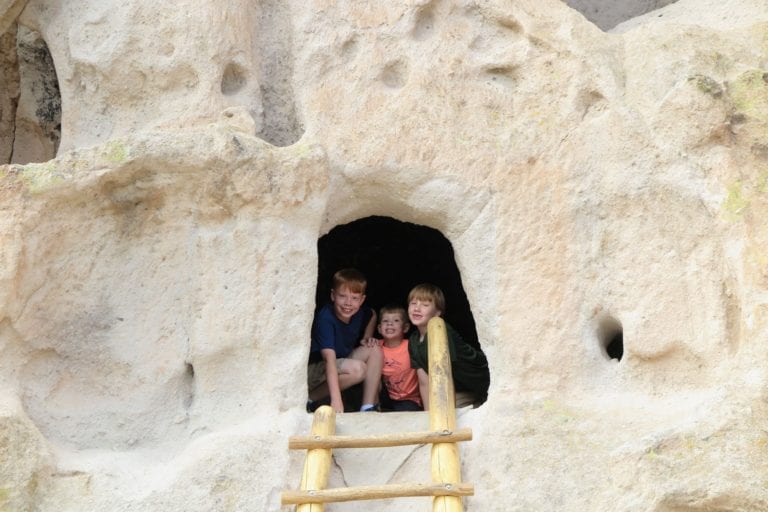
Visiting Bandelier National Monument was such an incredible experience for our family and I hope that your family loves it as much as we did!
I hope you found this information helpful in planning your visit to Bandelier National Monument.
Have a Great Trip with Your Traveling Feet!
If You Found This Post Helpful, Please Share / Pin It

POPULAR TOURS NEAR BANDELIER
Our Favorite Gear For Visiting Bandelier:
Great Kid's Books About Desert Life in the Southwest U.S.
Deserts by Gail Gibbons
This is a great book to help introduce elementary aged children to the characteristics of deserts and to the plants and animals that live in them. This book will help them understand the hardships of the desert and give them a glimpse into what the Ancestral Pueblo people may have faced.
Amazing Sites Nearby in New Mexico
Our Favorite Hike in NM
Continually Inhabited for 1,000 Years!
More Ideas for Your Vacation:
- Discovering Carlsbad Caverns, NM
- The Great Sand Dunes, CO (The Tallest Dunes in North America)
- 15 Top Things to Do in New Mexico for Families
Posts to Help You Plan Your Trip:
Traveling with Kids & Looking for Great Books?
10 Traveling Feet is a participant of Amazon Associates which means means we may receive a small commission, at no cost to you, if you make a purchase through a link. I will only recommend products that I have found useful and have loved using with my family. Thank you for supporting this website so that I may continue to bring you quality information.
